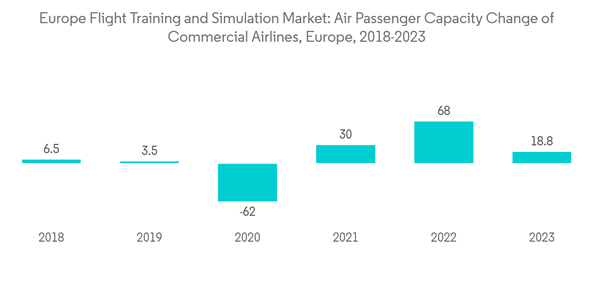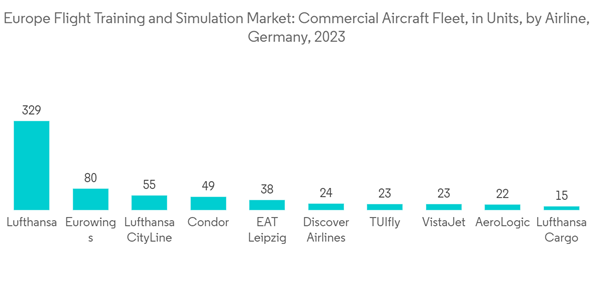The Europe Flight Training And Simulation Market size is estimated at USD 2.40 billion in 2024, and is expected to reach USD 2.9 billion by 2029, growing at a CAGR of 3.81% during the forecast period (2024-2029).
Increasing passenger traffic is encouraging airlines to procure new aircraft, which, in turn, is creating an acute pilot shortage. Thus, aviation training institutes in the region are modernizing their training capabilities via procuring new simulator equipment to train a larger batch of aviation aspirants per year while adhering to the certification criteria of the regulatory agencies.
Another driver for the market is the increasing demand for well-trained aviation pilots in Europe. As the aviation industry experiences continuous expansion and modernization, there is a growing demand for skilled pilots and crew members. Flight training and simulators play a critical role in providing realistic and immersive training experiences, enabling aspiring aviators to acquire the necessary skills in a safe and controlled environment.
Regulatory initiatives and standards set by aviation safety authorities also contribute to the market's growth. Compliance with stringent safety regulations necessitates standardized training programs, driving the adoption of advanced flight training and simulation systems. These systems enable training schools to align their programs with regulatory requirements, ensuring that pilots receive training that meets the highest safety standards.
Despite the demand, the adoption of flight simulators may be deterred by the inherently steep operational and maintenance costs that are multi-fold higher than the initial procurement price. Setting up a flight training institute requires a high initial investment in acquiring and maintaining advanced flight simulation systems. The cost of implementing state-of-the-art simulators can be restraining, particularly for smaller aviation training organizations and emerging players in the market.
With the increase in air travel demand, airlines are continuously recruiting and training pilots to operate fixed-wing aircraft. Flight simulators for fixed-wing platforms play a vital role in acclimatizing pilots to the complexities of modern commercial aviation, including large passenger aircraft and cargo planes. According to IATA, passenger trips are expected to increase by 4.2% annually over the next decade. Increasing air passenger traffic has forced airlines to expand their fleet size, which has increased the procurement of new aircraft.
Rising concern over aviation emissions has also shifted the focus toward new fuel-efficient aircraft models. The demand for skilled pilots extends beyond commercial airlines to military forces, where fixed-wing aircraft are integral. The introduction of the new fixed-wing aircraft model also generates the need for pilots trained on that aircraft, which, in turn, generates the demand for new fixed-wing simulators. Due to the introduction of such new aircraft, along with the requirement for trained pilots by commercial airlines, this market segment is expected to grow steadily over the forecast period.
For instance, in December 2022, Elbit Systems Ltd was awarded a contract of USD 36 million to provide four F-16 Full Mission Simulators (FMS) to the Polish Air Force (PLAF). These F-16 Full Mission Simulators (FMS) feature a 360-degree display system, and the interconnected simulators provide a high fidelity, full mission training experience. As per the contract, Elbit Systems’ training solution is expected to provide F-16 pilots with a range of skills, from basic familiarity with the F-16 aircraft to advanced combat flight competencies in complex operational scenarios.
The German government's proactive approach to fostering innovation plays a pivotal role in the country's dominance. For instance, in December 2023, CAE GmbH delivered a fully equipped NH90 training center to the German Navy. The advanced training facility includes multiple simulators for pilot training for the NH90 NTH Sea Lion naval transport helicopter. CAE was awarded a contract with the NSPA to supply the simulators in November 2019. The training facility includes high-fidelity simulators for training on the Mk88A Sea Lynx onboard helicopter, the P-3C Orion maritime patrol aircraft, and the NH90 NTH Sea Lion multi-role helicopter. As demand for skilled aviation professionals continues to grow, Germany's influence in this sector is likely to grow.
Aviation safety and regulatory bodies are expected to make changes in pilot training. They may also ease the eligibility criteria for getting a commercial pilot's license, crew, engineer, navigational training, and simulation activity. For instance, in December 2021, Coptersafety, the first and only independent international helicopter simulator Part 142 Training Center in Northern Europe, received certification as a Part-142 Training Center by the Federal Aviation Authority. Since then, it has also trained FAA-licensed pilots.
This product will be delivered within 2 business days.
Increasing passenger traffic is encouraging airlines to procure new aircraft, which, in turn, is creating an acute pilot shortage. Thus, aviation training institutes in the region are modernizing their training capabilities via procuring new simulator equipment to train a larger batch of aviation aspirants per year while adhering to the certification criteria of the regulatory agencies.
Another driver for the market is the increasing demand for well-trained aviation pilots in Europe. As the aviation industry experiences continuous expansion and modernization, there is a growing demand for skilled pilots and crew members. Flight training and simulators play a critical role in providing realistic and immersive training experiences, enabling aspiring aviators to acquire the necessary skills in a safe and controlled environment.
Regulatory initiatives and standards set by aviation safety authorities also contribute to the market's growth. Compliance with stringent safety regulations necessitates standardized training programs, driving the adoption of advanced flight training and simulation systems. These systems enable training schools to align their programs with regulatory requirements, ensuring that pilots receive training that meets the highest safety standards.
Despite the demand, the adoption of flight simulators may be deterred by the inherently steep operational and maintenance costs that are multi-fold higher than the initial procurement price. Setting up a flight training institute requires a high initial investment in acquiring and maintaining advanced flight simulation systems. The cost of implementing state-of-the-art simulators can be restraining, particularly for smaller aviation training organizations and emerging players in the market.
Europe Flight Training And Simulation Market Trends
Fixed-wing to Dominate Market Share during the Forecast Period
The fixed-wing segment had the largest market share in 2023, and it is expected to dominate the market throughout the forecast period. The major driver for the segment's market share is the sustained growth in the commercial aviation industry in Europe.With the increase in air travel demand, airlines are continuously recruiting and training pilots to operate fixed-wing aircraft. Flight simulators for fixed-wing platforms play a vital role in acclimatizing pilots to the complexities of modern commercial aviation, including large passenger aircraft and cargo planes. According to IATA, passenger trips are expected to increase by 4.2% annually over the next decade. Increasing air passenger traffic has forced airlines to expand their fleet size, which has increased the procurement of new aircraft.
Rising concern over aviation emissions has also shifted the focus toward new fuel-efficient aircraft models. The demand for skilled pilots extends beyond commercial airlines to military forces, where fixed-wing aircraft are integral. The introduction of the new fixed-wing aircraft model also generates the need for pilots trained on that aircraft, which, in turn, generates the demand for new fixed-wing simulators. Due to the introduction of such new aircraft, along with the requirement for trained pilots by commercial airlines, this market segment is expected to grow steadily over the forecast period.
For instance, in December 2022, Elbit Systems Ltd was awarded a contract of USD 36 million to provide four F-16 Full Mission Simulators (FMS) to the Polish Air Force (PLAF). These F-16 Full Mission Simulators (FMS) feature a 360-degree display system, and the interconnected simulators provide a high fidelity, full mission training experience. As per the contract, Elbit Systems’ training solution is expected to provide F-16 pilots with a range of skills, from basic familiarity with the F-16 aircraft to advanced combat flight competencies in complex operational scenarios.
Germany to Dominate the Market during the Forecast Period
Germany’s strategic positioning as an aviation hub, coupled with a strong infrastructure for aerospace research and development, provides a solid foundation for its dominance in flight training and simulation. One key factor contributing to Germany's dominance is the presence of world-class training institutions and simulation technology companies. These companies have established a reputation for superiority, attracting aspiring pilots from across Europe and globally. As a result, Germany is a preferred destination for those seeking top-notch flight training and simulation experiences.The German government's proactive approach to fostering innovation plays a pivotal role in the country's dominance. For instance, in December 2023, CAE GmbH delivered a fully equipped NH90 training center to the German Navy. The advanced training facility includes multiple simulators for pilot training for the NH90 NTH Sea Lion naval transport helicopter. CAE was awarded a contract with the NSPA to supply the simulators in November 2019. The training facility includes high-fidelity simulators for training on the Mk88A Sea Lynx onboard helicopter, the P-3C Orion maritime patrol aircraft, and the NH90 NTH Sea Lion multi-role helicopter. As demand for skilled aviation professionals continues to grow, Germany's influence in this sector is likely to grow.
Europe Flight Training And Simulation Industry Overview
The European flight training and simulation market is semi-consolidated. CAE Inc. is the market leader, mainly due to its huge geographical presence and brand image. L3Harris Technologies Inc., Thales, FlightSafety International Inc., and The Boeing Company are the other players who captured a significant share in the market.Aviation safety and regulatory bodies are expected to make changes in pilot training. They may also ease the eligibility criteria for getting a commercial pilot's license, crew, engineer, navigational training, and simulation activity. For instance, in December 2021, Coptersafety, the first and only independent international helicopter simulator Part 142 Training Center in Northern Europe, received certification as a Part-142 Training Center by the Federal Aviation Authority. Since then, it has also trained FAA-licensed pilots.
Additional Benefits:
- The market estimate (ME) sheet in Excel format
- 3 months of analyst support
This product will be delivered within 2 business days.
Table of Contents
1 INTRODUCTION
4 MARKET DYNAMICS
5 MARKET SEGMENTATION
6 COMPETITIVE LANDSCAPE
Methodology

LOADING...










